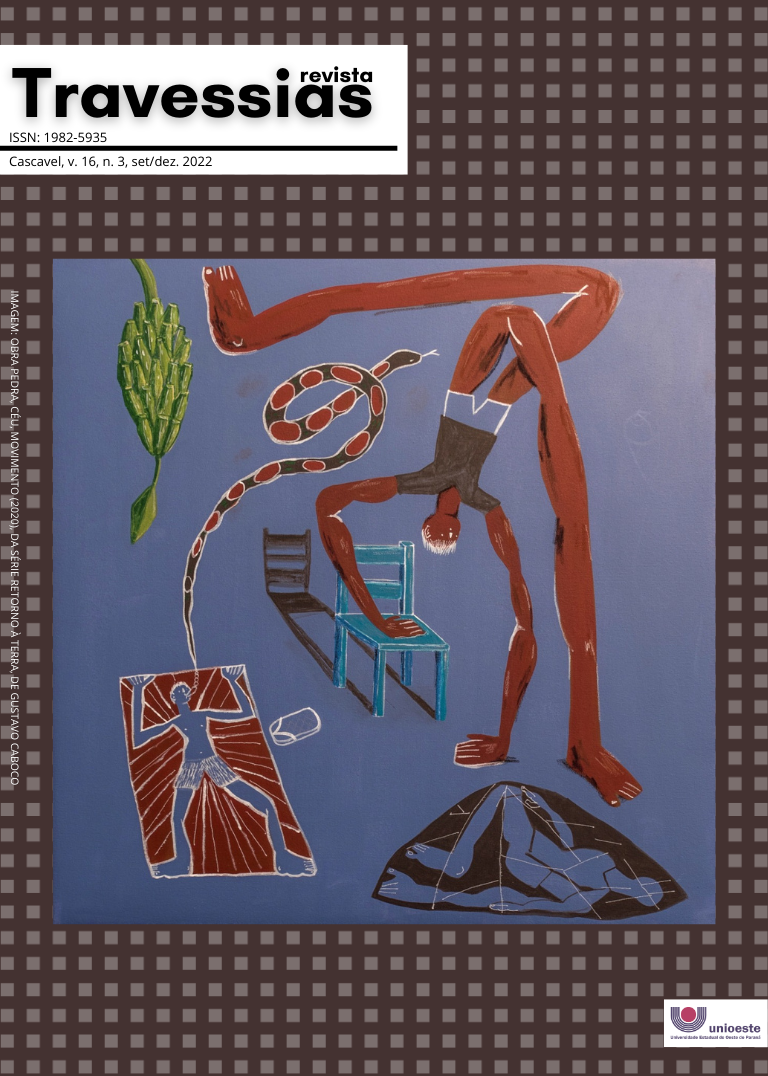What body is this?
The construction of female bodies in Sheyla Smanioto’s narrative
DOI:
https://doi.org/10.48075/rt.v16i3.29924Keywords:
female bodies, body tipology, Elódia Xavier, DesesterroAbstract
In recent decades, the female body has been re-signified as an analytical category and understood in its socio-historical concreteness, no longer summarized in tis merely biological condition. Based on this assumption, the objective of this article is analyzing how the female body is represented in contemporary literature by women. To achieve this purpose, we orient ourselves through the foundations of the typology of the representation of the body in literary texts written by women, developed by Elódia Xavier, a renowned researcher in the field of Brazilian and female literature, in the book intitled Que corpo é esse? O corpo no imaginário feminino (2021) — whose title of the present research makes a direct reference. The work selected as the corpus for this analysis was the award-winning debut novel by the contemporary author Sheyla Smanioto, Desesterro (2015), which narrates the harsh reality of four generations of women in the Brazil's northeast, constantly subjected to various manifestations of violence. The results achieved point to the multiplicity ot Smaniotian female characters, which can fit into different body categories listed by Elódia Xavier. Sheyla Smanioto introduces us to characters that are the result of violence to denounce and problematize the naturalization of structures of domination, in addiction to showing that there are other paths and possibilities for the female body.
Downloads
References
DALCASTAGNÈ, Regina. A personagem do romance brasileiro contemporâneo: 1990-2004. Estudos de Literatura Brasileira Contemporânea. Brasília, n. 26, p. 13-71, 2005.
DOLL, Karine Mathias. Sobre mulheres subterrâneas e exumação narrativa: uma leitura de Desesterro (2015), de Sheyla Smanioto. Eixo Roda. Belo Horizonte, v. 29, n. 3, p. 208-226, 2020.
HOOKS, bell. Erguer a voz: pensar como feminista, pensar como negra. Tradução de Cátia Bocaiuva Maringolo. São Paulo: Elefante, 2019.
IBGE — INSTITUTO BRASILEIRO DE GEOGRAFIA E ESTATÍSTICA. Pesquisa Nacional por Amostra de Domicílios Contínua 2019. Rio de Janeiro: IBGE, 2020.
KLUMB, Stefani Andersson. Mulheres marcadas: a ficcionalização da violência contra a mulher na literatura brasileira. 2021. 109 páginas. Trabalho de Conclusão de Curso de Letras — Espanhol e Português como Línguas Estrangeiras — Universidade Federal da Integração Latino-Americana, Foz do Iguaçu, 2021.
LUGONES, María. Colonialidade e gênero. In: HOLLANDA, Heloisa Buarque de. Pensamentos feministas hoje: perspectivas decoloniais. Tradução de Pê Moreira, Bárbara Martins, Bruna Mendes, Cristine Carvalho, Igor Ojeda, Juliana Araújo e Juliana Luz. Rio de Janeiro: Bazar do Tempo, 2020, p. 53-83.
PEREIRA, Maria do Rosário Alves. Que corpo é esse na literatura contemporânea escrita por mulheres? Revista Fórum Identidades. Itabaiana-SE, Universidade Federal de Sergipe, v. 33, nº 1, p. 87-100, 2021.
SMANIOTO, Sheyla. Desesterro. Rio de Janeiro: Record, 2018.
SPIVAK, Gayatri Chakravorty. Pode o subalterno falar? Tradução de Sandra Regina Goulart Almeida, Marcos Pereira Feitosa e André Pereira Feitosa. Belo Horizonte: Editora UFMG, 2010.
XAVIER, Elódia. Que corpo é esse? O corpo no imaginário feminino. Rio de Janeiro: Oficina Raquel, 2021.
Downloads
Published
How to Cite
Issue
Section
License
Copyright (c) 2022 Authors keep the copyright and grant the journal the right of first publication, with the work simultaneously licensed under the Creative Commons Attribution License (CC-BY-NC-SA 4.0), which allows sharing the trial with acknowledgment of authorship and initial publication in this journal.

This work is licensed under a Creative Commons Attribution-NonCommercial-ShareAlike 4.0 International License.
Creative Copyright Notice
Policy for Free Access Journals
Authors who publish in this journal agree to the following terms:
1. Authors keep the copyright and grant the journal the right of first publication, with the work simultaneously licensed under the Creative Commons Attribution License, which allows sharing the trial with acknowledgment of authorship and initial publication in this journal.
2. Authors are authorized to take additional contracts separately, for non-exclusive distribution of the work version, published in this journal (eg publish in institutional repository or as a book chapter), with acknowledgment of authorship and initial publication in this journal.
3. Authors are allowed and encouraged to publish and distribute their work online (eg in institutional repositories or on their personal page) at any point before or during the editorial process, as this can generate productive changes, as well as increase both impact and citation of the published trial (See The Effect of Free Access).
Creative Commons License
This work is licensed under a Creative Commons Attribution–NonCommercial-shareaswell 4.0 International License, which allows you to share, copy, distribute, display, reproduce, completely or part of the work, since there is no commercial purpose, and authors and source are cited.



